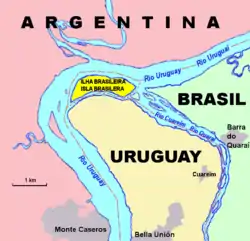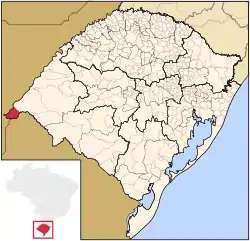Brazilian Island
Brazilian Island (Portuguese: Ilha Brasileira; in Standard Spanish: Isla Brasileña; in Portuñol/Portunhol: Isla Brasilera1) is a small uninhabited river island at the confluence of the Uruguay River and the Quaraí (Cuareim) River, between the borders of Argentina, Brazil and Uruguay, which is disputed by the two latter countries. The island is approximately 3.7 km (2.3 mi) long by 0.9 km (0.6 mi) wide, and it is located at 30°10′56″S 57°37′43″W.
| Disputed island Other names: Ilha Brasileira, Isla Brasileña | |
|---|---|
 | |
| Geography | |
| Location | Uruguay River |
| Coordinates | 30.185°S 57.63°W |
| Total islands | 1 |
| Area | 2.5 km2 (0.96 sq.mi.) (approximate) |
| Administered by | |
| none in practice | |
| Claimed by | |
| State | |
| Municipality | Barra do Quaraí |
| Department | |
| Demographics | |
| Population | uninhabited |

Overview
The island has long been claimed by both Brazil and Uruguay. Brazilian officials claim that the island is within their municipality of Barra do Quaraí, state of Rio Grande do Sul. Uruguayan officials claim that the island is part of their municipality of Bella Unión, in Artigas Department.[1] However, neither country has shown interest in actively enforcing its claims to the island, for example by sending troops there. Like the other territorial dispute between Brazil and Uruguay in the vicinity of Masoller, it has not prevented close and friendly diplomatic and economic ties between the two countries.
From 1964 to 2011, the island had a single house and a single inhabitant, a Brazilian farmer called José Jorge Daniel. In 2011, suffering from health problems, Mr. Daniel moved out of the island to live with relatives in the nearby city of Uruguaiana, Brazil, where he died shortly afterwards, aged 93 or 95 (sources differ).[2][3] Since then, the island has been uninhabited and unoccupied.
On 7 August 2009, the island suffered severe damage by a fire caused by unknown reasons (though arson was suspected), which burned at least 40% of the island's area. The fire was eventually put out by a joint transnational effort by the firefighters from Barra do Quaraí and Bella Unión. Mr. Daniel, who still lived there at the time, and his house were unscathed.[4] Since then, teams of biologists and students from nearby Brazilian universities, supported by Brazilian and Uruguayan ecological NGOs, have gone on occasional expeditions to the island to study the fire damage to local wildlife and try to restore its former ecosystem.[3]
See also
- Masoller - Uruguayan village located next to another disputed area on the Brazilian border.
Note
^ In standard Spanish, the word "Brazilian" is brasileño/brasileña, but in the Southern Cone, most particularly in Argentina, Uruguay and Paraguay, the portuñol term brasilero/brasilera is more commonly used.
References
- ....uncontested dispute (between Brazil and Uruguay) over certain islands in the Quarai/Cuareim.....and the resulting tripoint with Argentina CIA. "CIA World Factbook: Uruguay: Transnational Issues". U.S. Government. Retrieved 2009-12-26.
- Griswold, Clark (2013-03-10). "As atuais disputas territoriais brasileiras" [The current territorial disputes of Brazil]. Férias do Clark (personal blog) (in Portuguese). Retrieved 2014-01-09.
- "Uma ilha sem guardião à espera de preservação" [An island without a guardian waiting to be preserved]. Central Sul de Jornais (in Portuguese). 2011-07-04. Archived from the original on 2016-03-04. Retrieved 2014-01-09.
- "Fogo destrói vegetação na tríplice fronteira entre Brasil, Argentina e Uruguai" [Fire destroys vegetation on the triple border between Brazil, Argentina, and Uruguay]. Globo.com (G1 portal) (in Portuguese). 2009-08-08. Retrieved 2014-01-09.
